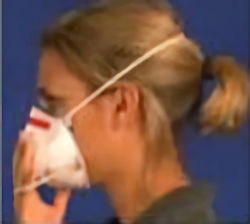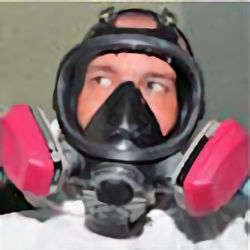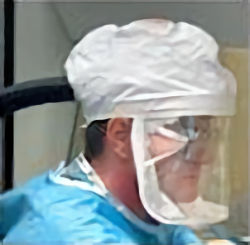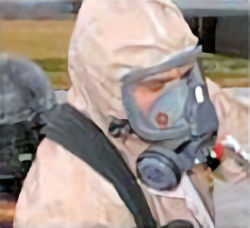Respiratory Protection
Respirator Types
The appropriate respirator will depend on the contaminant(s) to which you are exposed and the protection factor (PF) required. Required respirators must be NIOSH-approved and medical evaluation and training must be provided before use.
Particulate Respirators: These respirators are the simplest, most common (in construction), and least expensive, but least protective of the respirator types available. These respirators only protect against particles (e.g., dust). They do not protect against chemicals, gases, or vapors, and are intended only for low hazard levels.
The commonly known "N-95" filtering face piece respirator or "dust mask" is another, more protective, type of particulate respirator, often used in hospitals to protect against infectious agents. Below are listed the two types of dust masks and four types of filtering and air-purifying respirators.
Single-Strap Dust Masks: These are lightweight, disposable masks designed to provide basic protection against non-toxic dust particles and airborne contaminants.
Single-Strap Dust Mask

They typically have a single strap that goes around the back of the head to hold the mask in place. Single-strap dust masks do not offer a tight seal and are not suitable for protection against hazardous gases, vapors, or fine particles.
Approved Filtering Face Pieces: Approved filtering face pieces (dust masks) can be used for dust, mists, welding fumes, etc.
Filtering Face Piece

They do not provide protection from gases or vapors. They are also known as N95 respirators, are designed to filter out at least 95% of airborne particles, including hazardous substances such as dust, mist, and certain types of biological particles.
They are more robust than single-strap dust masks and have multiple layers of filter material to provide a better seal around the nose and mouth.
DO NOT USE FOR ASBESTOS OR LEAD. Instead, select from the respirators below.
Half-face Respirators: Half-face respirators can be used for protection against most vapors, acid gases, dust or welding fumes.
Half-Face Respirator

They cover the nose, mouth, and chin, providing respiratory protection against airborne contaminants. They consist of a facepiece that seals against the face and has filters to remove contaminants from the air.
Half-face respirators are compatible with different types of filters, such as particulate filters, gas/vapor filters, or combination filters, depending on the specific hazards present. Cartridges/filters must match contaminant(s) and be changed periodically.
Full-face respirators: Full-face respirators are more protective than half-face respirators. They can also be used for protection against most vapors, acid gases, dust or welding fumes. They cover the entire face, including the eyes, nose, mouth, and chin.
Full-Face Respirator

They provide superior respiratory protection and also offer eye protection against airborne particles, gases, vapors, or liquids. Full-face respirators have a wide field of view and a clear visor or lens to allow users to see clearly while wearing them.
Cartridges/filters must match contaminant(s) and be changed periodically.
Loose-fitting powered-air-purifying respirators (PAPR): PAPRs consist of a loose-fitting hood or helmet that covers the head and a powered unit that delivers filtered air to the user.
Loose Fitting PAP Respirator

They are equipped with a blower that draws in ambient air through filters to remove contaminants before supplying clean, filtered air to the user's breathing zone. PAPRs are often used in environments where a tight-fitting facepiece may not be feasible or comfortable, such as in healthcare settings or for protection against specific respiratory hazards.
They can be worn by most workers who have beards. Cartridges/filters must match contaminant(s) and be changed periodically.
Self-Contained Breathing Apparatus (SCBA). A Self-Contained Breathing Apparatus is used for entry and escape from atmospheres that are considered immediately dangerous to life and health (IDLH) or oxygen deficient.
SCBA Respirator

They consist of a full-face mask, a high-pressure air cylinder worn on the back, and a regulator that supplies breathing air from the cylinder. SCBAs provide a complete source of breathable air, independent of the ambient atmosphere.
They are commonly used by firefighters, hazmat teams, and in other high-risk situations.
Knowledge Check Choose the best answer for the question.
10-8. What is the simplest, most common (in construction), and least expensive, but least protective of the respirator types available?
You forgot to answer the question!
